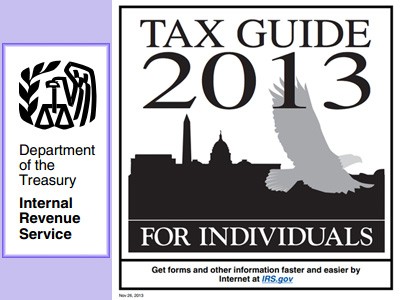With a little more than two weeks to go before income-tax filing season begins, you might want to start pondering tips for consumers and small businesses.
The Internal Revenue Service has said it will open the season a bit later this year, on Jan. 31, because it lost time last fall during the government shutdown.
For the nuts and bolts of the filing process, if you are planning a primer or infobox, settle in with the latest version of IRS Publication 17. For a tax tome it’s a pretty entertaining read and the “What’s new” sections will be particularly helpful in composing your how-to stories.
But beyond primers and tax guides, you might use this period to seek out individuals, small business owners and others in your community and show through the tax filing process who’s gaining and who’s losing in the post-recession economy.
“IRS Publication 17: For a tax tome
it’s a pretty entertaining read
and the What’s New sections
will be particularly helpful.”
It’s fairly axiomatic that people who expect to be due refunds file early, while those who expect to owe money prefer to wait until deadline in April before sending off their returns and their cash. So for early stories, you might find ways to illustrate the local economy and jobs market through the stories of people who are filing as soon as possible to get the earned-income tax credit (EITC) or who, through perhaps reduced income, may be getting – and depending on – larger refunds than in previous years.
Here are the EITC statistics, by state, for 2012 and several previous years; as you can see, EITC (which is not really a tax credit but a sort of welfare or financial boost aimed at low-income working people; mostly those with children in the household, and administered through the income-tax filing system) rose by more than $1 billion from 2011 returns to the 2012 returns filed last year. How do the past years’ figures stack up on your state, and what does increased eligibility say about wages, jobs and household prosperity (or lack thereof.) Can you illustrate – using actual documentation like prior years’ tax returns, pay stubs, bank statements and the like – how family fortunes have ebbed and flowed since the recession?
Putting a human face on the economic issues that tax filings reflect is an interesting way to approach the season. To find subjects, as for help at the volunteer tax preparation programs – here are two endorsed by the IRS – and at churches, social service agencies and other entities that provide assistance. You can also check with commercial tax preparation firms.

Providing practical tips like how to avoid refund anticipation loan scams, how to adjust paperwork to receive EITC year-round or to lower withholding, may be worthwhile. However, some people without the discipline to apply extra funds where they’ll do the most good may be better off with the annual lump sums. What do your subjects plan to do with the money? Pay off debt, purchase health care service, or the like? If you are working on any income-inequality stories, this is s another way to give insight into how lower-income people juggle financial matters.
You can adapt this idea to any beat. If you cover health care, you might ask tax professionals and individuals about any trends in deductions for medical expenses; are they up as more out-of-work people lost health insurance? (I’ll do a separate post in future weeks about the ACA and tax filing.) If you cover small business, look at the trend of contract workers, freelancers and out-of-work people attempting to start consulting businesses; this changes an individual’s tax filing status.
This shift to an “entrepreneurial economy” in which workers are classified as independent contractors, paid via 1099 income vs. W-2 wages, may be reflected in tax statistics or at least in anecdotal information from tax preparers. The IRS statistics of income series includes a number of tables and reports about individual filing patterns and reports related to various demographics, such as sex or age. I do not know if they will run a custom report for you – say, 1099 income by state for the past couple of years, so you can spot trends – but it’s certainly worth a try. If you have a CAR reporter on deck, she or he might be able to help find the data as well.
The point is, taxation reflects income, employment, relationships, health, where and how one dwells, what one owes, and many other facets of life related to the economy and well-being. This is a great opportunity to mine it for human interest stories that reflect your market.











